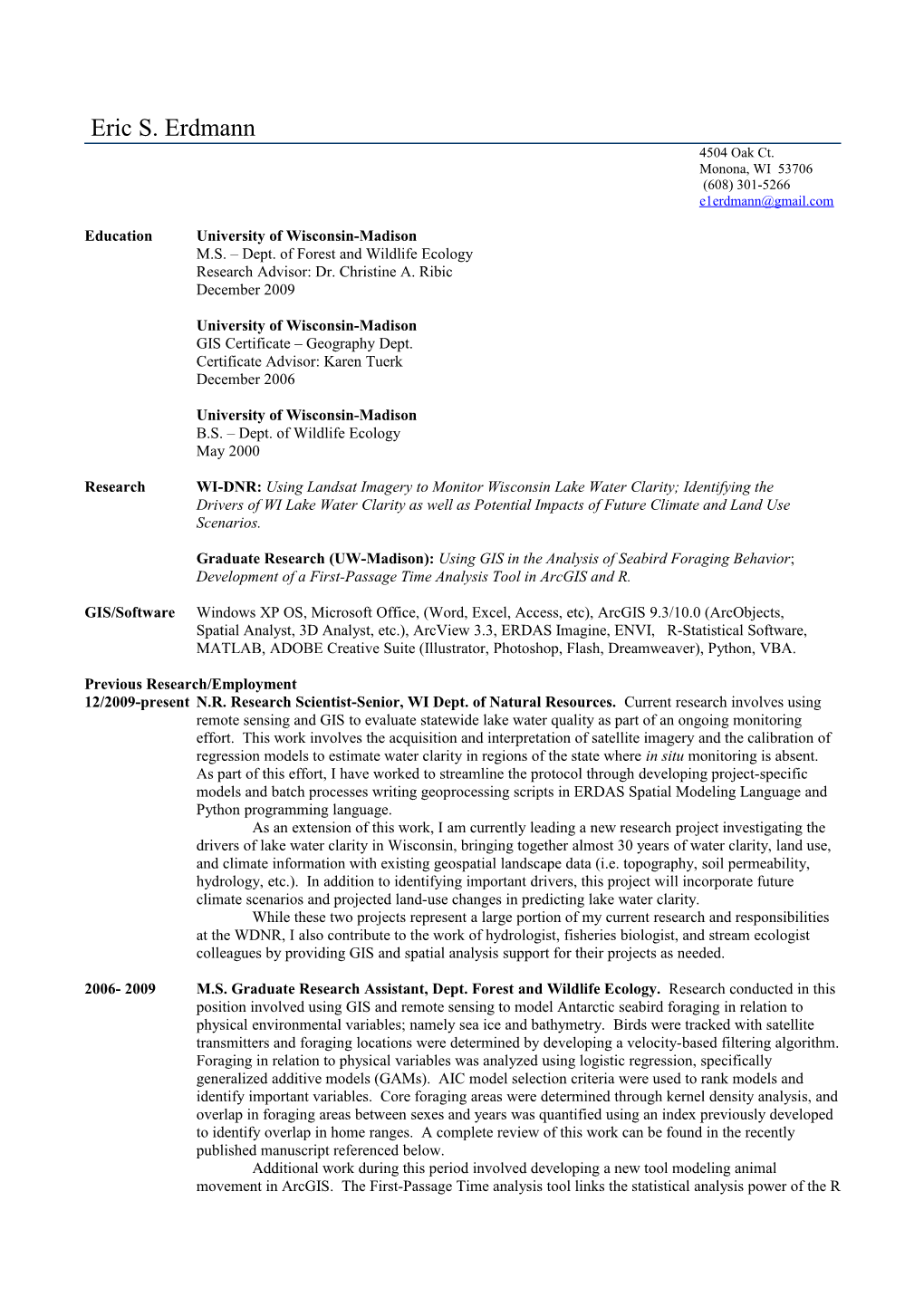Eric S. Erdmann
4504 Oak Ct.
Monona, WI 53706
(608) 301-5266
EducationUniversity of Wisconsin-Madison
M.S. – Dept. of Forest and Wildlife Ecology
Research Advisor: Dr. Christine A. Ribic
December 2009
University of Wisconsin-Madison
GIS Certificate – Geography Dept.
Certificate Advisor: Karen Tuerk
December 2006
University of Wisconsin-Madison
B.S. – Dept. of Wildlife Ecology
May 2000
ResearchWI-DNR:Using Landsat Imagery to Monitor Wisconsin Lake Water Clarity; Identifying the Drivers of WI Lake Water Clarity as well as Potential Impacts of Future Climate and Land Use Scenarios.
Graduate Research (UW-Madison):Using GIS in the Analysis of Seabird Foraging Behavior; Development of a First-Passage Time Analysis Tool in ArcGIS and R.
GIS/SoftwareWindows XP OS, Microsoft Office, (Word, Excel, Access, etc), ArcGIS 9.3/10.0 (ArcObjects,
Spatial Analyst, 3D Analyst, etc.), ArcView 3.3, ERDAS Imagine, ENVI, R-Statistical Software, MATLAB, ADOBE Creative Suite (Illustrator, Photoshop, Flash, Dreamweaver), Python, VBA.
Previous Research/Employment
12/2009-presentN.R. Research Scientist-Senior, WI Dept. of Natural Resources. Current research involves using remote sensing and GIS to evaluate statewide lake water quality as part of an ongoing monitoring effort. This work involves the acquisition and interpretation of satellite imagery and the calibration of regression models to estimate water clarity in regions of the state where in situ monitoring is absent. As part of this effort, I have worked to streamline the protocol through developing project-specific models and batch processes writing geoprocessing scripts in ERDAS Spatial Modeling Language and Python programming language.
As an extension of this work, I am currently leading a new research project investigating the drivers of lake water clarity in Wisconsin, bringing together almost 30 years of water clarity, land use, and climate information with existing geospatial landscape data (i.e. topography, soil permeability, hydrology, etc.). In addition to identifying important drivers, this project will incorporate future climate scenarios and projected land-use changes in predicting lake water clarity.
While these two projects represent a large portion of my current research and responsibilities at the WDNR, I also contribute to the work of hydrologist, fisheries biologist, and stream ecologist colleagues by providing GIS and spatial analysis support for their projects as needed.
2006- 2009M.S. Graduate Research Assistant, Dept. Forest and Wildlife Ecology. Research conducted in this position involved using GIS and remote sensing to model Antarctic seabird foraging in relation tophysical environmental variables; namely sea ice and bathymetry. Birds were tracked with satellite transmitters and foraging locations were determined by developing a velocity-based filtering algorithm. Foraging in relation to physical variables was analyzed using logistic regression, specifically generalized additive models (GAMs). AIC model selection criteria were used to rank models and identify important variables. Core foraging areas were determined through kernel density analysis, and overlap in foraging areas between sexes and years was quantified using an index previously developed to identify overlap in home ranges. A complete review of this work can be found in the recently published manuscript referenced below.
Additional work during this period involved developing a new tool modeling animal movement in ArcGIS. The First-Passage Time analysis tool links the statistical analysis power of the R environment to geospatial data in ArcGIS. The tool was built to specifically run first-passage time analysis, but the framework developed can be used to access any R analysis package from within the ArcMap 9.2 interface.
I continue to collaborate with faculty in Forest and Wildlife Ecology, providing GIS and spatial analysis support for several ongoing research projects. I have also been invited as a guest lecturer to assist with GIS training and updating undergraduate coursework related to animal movement and geospatial analysis.
2/06-8/06IS Data Services Professional, WI Dept. of Natural Resources. Assisted in the development of the Designated Waters database as well as delineation in the DNR’s Surface Water Data Viewer. Responsibilities included database development/management, digitizing water bodies, some web page maintenance, and developing a training guide for ArcPad field mapping. Left position to pursue Master’s degree.
PublicationsRibic, C.A., S.B. Sheavly, D.J. Rugg, E.S. Erdmann. 2011. Trends in marine debris along the U.S. Pacific Coast and Hawai’i 1998-2007. Marine Pollution Bulletin 64: 994-1004.
Mikulyuk, A., S. Sharma, S. Van Egeren, E. Erdmann, M. Nault, J. Hauxwell. 2011. The relative role of environmental, spatial and land-use patterns in explaining aquaticmacrophyte community composition. Canadian Journal of Fisheries and Aquatic Sciences 68: 1778-1789.
Erdmann, E.S., C.A. Ribic, D.L. Patterson-Fraser, W.R. Fraser. 2011. Characterization of winter foraging locations of Adélie Penguins along the Western Antarctic Peninsula, 2001-2002. Deep Sea Research Part II: Topical Studies in Oceanography 58: 1710-1718.
Ribic, C.A., S.B. Sheavly, D.J. Rugg, E.S. Erdmann. 2010. Trends and Drivers of Marine Debris on the Atlantic Coast of the United States 1997-2007. Marine Pollution Bulletin 60:1231-1242.
Gorman, K.B., E.S. Erdmann, B.C. Pickering, P.J. Horne, J.R. Blum, H.M. Lucas, D.L. Patterson-Fraser, W.R. Fraser. 2010. A new high-latitude record for the Macaroni Penguin (Eudypteschrysolophus) at Avian Island, Antarctica. Polar Biology33:1155-1158.
Devenish, E.S., H.P. Nelson, F. Lucas, E. Erdmann. 2007. A preliminary assessment of the species richness of the Madamas Watershed: a proposed national park. Living World, Journal of the Trinidad and Tobago Field Naturalists’ Club, pp. 69-78.
